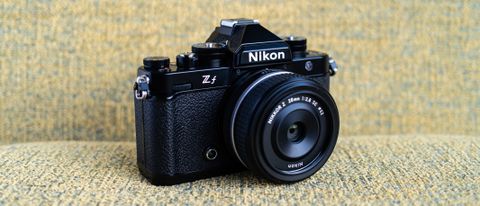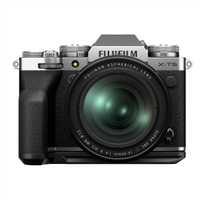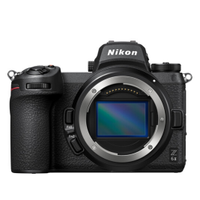TechRadar Verdict
For retro-camera lovers, the full-frame mirrorless Nikon Zf is the first proper Fujifilm alternative. It’s a more faithful reimagining of the Nikon FM2 than the crop-sensor Zfc, with lovely flourishes that includes brass dials, a threaded shutter button that accepts a cable release, and a new B&W mode. The Zf isn’t just about old-school looks, though – it also packs a punch, with Nikon’s latest processor, 24.5MP stills up to 30fps, its best in-body image stabilization yet, and powerful autofocus. You might not need the Zf for its photo and video prowess, but you’ll want it for how it looks and feels.
Pros
- +
Beautiful design and gorgeous flourishes
- +
New color profiles
- +
Nikon’s best in-body image stabilization yet
Cons
- -
Could be better served by Z7 II sensor
- -
Limited choice of retro-styled mirrorless Z lenses
- -
Memory card types limit performance potential
Why you can trust TechRadar
Editor's Note
• Original review date: September 2023
• Launch price: $1,999.95 / £2,299 / AU$3,499
• Official price now: around $1,799.95 / £1,699 / AU$2,948.89
Update: November 2024. Released in October 2023, the Nikon Zf remains a fantastic full-frame mirrorless camera a year later. Its retro design is still a beautiful thing to behold and hold, while its performance continues to stack up well against many of the best mirrorless cameras. Excellent in-body image stabilization, capable autofocus and a proven 24.5MP sensor all combine to make it an excellent stills camera. What makes it even more appealing today is the fact that reductions have brought the price down by a meaningful amount, making the Zf even better value if you want an enthusiast-grade camera with no shortage of retro style.

Vintage camera styling is big business: photographers love it. Whether SLR veterans who cut their photographic teeth in the film era looking for something familiar but packing the latest digital technology, or younger photographers looking for a more tactile shooting experience in a feature-packed yet beautifully designed retro-inspired camera, their popularity never seems to waver. The Nikon Z f ticks all of those boxes.
The Nikon Z f builds on the offering of the enthusiast-level APS-C Nikon Z fc unveiled in 2021, fulfilling our wishes for a higher-quality, full-frame retro mirrorless camera. Both are inspired by the iconic Nikon FM2, and the new Zf ditches that ‘c’ from the Zfc that denotes ‘casual’ use, and is a pricier, serious, everyday camera that again looks the part if you love the film photography aesthetic, adding beautiful flourishes for the discerning eye.
During a sneak peek of the Zf ahead of the its worldwide announcement, I had both the Zf and Zfc in my hand and the two cameras largely look and feel the same; the Zf is slightly larger, with a raised bump for a handgrip. A look into the viewfinder reveals a slightly more expansive view, too – like many of the camera's core features, the 3.69m-dot 0.50-inch viewfinder with 0.8x magnification is inherited from the full-frame Nikon Z6 II.




The shutter button now includes a thread for screwing in a cable release – in a modern mirrorless camera world, that’s seriously old-school, and will appeal to photographers of a certain vintage. There’s also a new B&W mode on the photo and video switch that's positioned under the shutter speed dial, and Nikon has added two new monochrome color profiles in an attempt to go toe-to-toe with Fujifilm’s ever-expanding and popular Film Simulation looks.
And then there’s what you can’t see: a top and front magnesium alloy chassis which makes the Zf a tougher camera than the Zfc, while the shutter speed and ISO dials are made from brass, which we’re told will weather to reveal those glorious brass-tones with prolonged use. The Zfc looks the part, but the Zf adds a bit of ruggedness that FM2 owners would expect, and is a more faithful reimagining of that legendary camera.
Features-wise, the Zf inherits a lot of its core components from the Z6 II, including a full-frame 24.5MP sensor. At the rumors stage, I had speculated that the Zf would get the 45.7MP sensor of the Z7 II, and for a camera that's designed primarily for small lenses like the retro Nikkor Z 28mm F/2.8 SE, I wish there were more pixels to play with; that way you’d have more cropping potential in your pictures for the times when you can’t get close enough, as you get with another everyday camera, the 61MP Leica Q3.
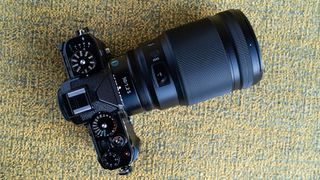
Still, the 24.5MP full-frame sensor is a proven performer, and it’s served me well in my own Z6 II, which has been my go-to camera for events, weddings and portrait photography sessions. The Zf also gets the latest EXPEED 7 processor, as found in the excellent Nikon Z8, and intelligent autofocus, so it’ll be a speedier performer, albeit limited by its slower SD and micro SD storage media (compared to CFExpress).
Using Z6 II-level tech means the Zf list price is closer to the $2,000 / £2,000 / AU$3,500 mark, too, whereas the Z7 II is pricier by around 30%. Pitching the Zf at the Z6 II price point enables it to go directly up against Fujifilm’s best offerings, like the X-T5 so perhaps it’s a good call from Nikon after all. The Zf won’t handle as well as the Z6 II in various demanding scenarios, but it will feel the part, and bring that enjoyable and tactile experience, making it one for the wishlist.
Nikon Zf: Release date and price
The Nikon Zf body-only list price is $1,999.95 / £2,299 / AU$3,499 in the US, UK and Australia, or it can be purchased with the Z 40mm F2 lens for $2,239 / £2,519 / AU$3,999, or with the Z 24-70mm F4 lens for $2,599 / £2,849 (not in Australia). The Zf will be available for pre-order from October 2023, in black only from third-party online retailers, while if you shop at the Nikon store it comes in six color variations.
For me, it’s the fully black option that delivers the most refined and truly vintage look, and it’s the Z f + 40 SE kit that will make the most sense in terms of value, styling and balancing with the Z f’s size, shape and weight.
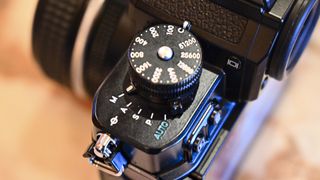
It's the back of the camera that’s the main giveaway that the Z f is a mirrorless camera, with Nikon’s standard button configuration alongside the 2.1m-dot 3.2-inch touchscreen. It’s the first Nikon full-frame mirrorless camera with a vari-angle touchscreen that can be flipped out to the side for easy viewing from multiple angles, or folded away completely, as if the camera had no rear screen at all – that should appeal to old-school photographers. In that setup you get to enjoy the improved leather-finish effect, which as mentioned before is available in six different colors direct from Nikon, though a Fujifilm X-Pro 3-inspired film window on that rear would be an even nicer touch.
- Price score: 4.5/5
Nikon Z f: Features and performance
- 8-stop AI assisted Vibration Reduction
- Highly capable 299-point AF system
- Subject detection manual focus
When you see the Z f you could be forgiven for assuming that its performance and features are more in line with Leica M-series cameras, but the Z f is a technological powerhouse; it’s a little like putting a Porsche 911 engine in a vintage VW Beatle; retro charm on the outside with a powerful surprise under the bonnet. The impressive performance of the Z f is delivered thanks to the Expeed 7 image processing engine, which is the same processor used in the Z 9.
Autofocus utilizes hybrid phase-detection/contrast AF with AF assist, and the AF system is outstanding as confirmed in testing. It certainly lives up to Nikon’s comparison of the Z f’s tracking AF performance to that of the flagship Nikon Z9. Subject tracking includes humans, animals (with eye AF), cars, motorbikes, bikes, trains and planes.
Plus, there’s a 299-point AF array (273-points in single-point AF mode) that covers 89x96% of the viewfinder and provides an incredible -10EV sensitivity. In reality, as is often the case with low light AF performance of most cameras, while it works, in extremely low light the Z f’s autofocus is labored compared to brighter conditions.
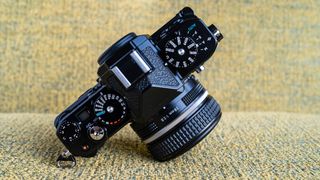
Then there’s the subject-detection manual focus assist which is claimed to work with vintage lenses, and although this was only tested with Z-series lenses it did work exceptionally well. In a nutshell, you select the subject type and when manually focusing the Z f will, for instance, detect the eyes of the subject when set to people and the square around the eye changes from white to green when the eye is in focus.
The view is supposed to automatically jump to a magnified view of the detected eye to further assist with manual focus accuracy, but I was unable to switch this element of the feature on. Further adding to focus accuracy, when manually focusing without subject detection switched on, the active AF point, while not in use for AF, can be repositioned over the desired point of focus and turns green when sharp; it’s an amazing feature that reminds me of rangefinder focusing, but even better.
Another standout feature is the 8-stop, 5-axis, AI-assisted in-body Vibration Reduction. That’s quite a mouthful and a huge amount of functionality that gives the Z f next-generation Image Stabilization. In use, the Vibration Reduction is highly effective, allowing you to shoot at shutter speeds much slower than you could without. There’s also subject detection-assisted vibration reduction where the Z f communicates with the sensor to adjust its axis depending on where the detected subject is in the frame, to achieve more effective vibration reduction. This is a tricky feature to test in isolation, but as previously mentioned, the Vibration Reduction is excellent overall.





The Z f is also a competent performer when it comes to continuous shooting with the ability to shoot at up to 30fps. The bottleneck here is that the camera uses SD and microSD cards, rather than the faster, and much more expensive, CFExpress cards. So, shooting in the C30 mode for this continuous shooting speed using a Lexar Professional 1000x SDXC card, the Z f managed to capture JPEGs at Normal quality (the limit) for 20 seconds until the buffer stuttered. For Raw files in Continuous Hi+ mode at 14fps, the Z f shot for 11 seconds until the buffer stuttered. It’s far from a scientific test, but does give you an idea of what to expect with a medium-spec SD card.
There are many other features besides those mentioned here, but ultimately far too many to cover without making a list. But suffice to say, the Z f, despite its vintage appearance, is at the forefront of Nikon’s camera technology and is packed with most, if not all of the features and functionality that you could ever need or want at this moment in time.
- Features and performance score: 4.5/5
Nikon Z f: Design
- First full-frame Nikon mirrorless with vari-angle touchscreen
- Twin SD and micro SD card slots limit shooting potential
- Uses same EN-EL15c battery as Z8
The Z f takes its design cues from the iconic Nikon FM2, with tactile direct access controls covering both traditional controls you find on analogue SLRs and those that are firmly a product of the digital era. Even the shutter button features a screw thread for a manual cable release, further adding to its retro charm. The overall design is certainly faithful to the FM2, to the point where people could easily mistake it for an analogue camera.
Tough like the FM2 but with a modern twist, the Z f features a top and front magnesium alloy chassis alongside brass shutter speed, ISO and exposure compensation dials that Nikon says will weather aesthetically with prolonged use to reveal the brass beneath the stylish back paint. The Z f certainly looks the part, and far from being style over substance, it’s packed with impressive features and it’s fair to say that the design does indeed provide a pleasurable shooting experience.






It's the back of the camera that’s the main giveaway that the Z f is a mirrorless camera, with Nikon’s standard button configuration alongside the 2.1m-dot 3.2-inch touchscreen. It’s the first Nikon full-frame mirrorless camera with a vari-angle touchscreen that can be flipped out to the side for easy viewing from multiple angles, or folded away completely, as if the camera had no rear screen at all – that should appeal to old-school photographers. In that setup you get to enjoy the improved leather-finish effect, which as mentioned before is available in six different colors direct from Nikon, though a Fujifilm X-Pro 3-inspired film window on that rear would be an even nicer touch.
Shooting modes are accessed using a switch at the bottom of the ISO dial, with B&W, Photo and Video modes accessed with a switch below the shutter speed button. A nice, and incredibly useful addition to the top plate is a small LCD screen that displays the current aperture in the absence of manual aperture rings on Z-series lenses.




In the hand, the Z f feels comfortable and the tactile controls are a delight to use. There’s no denying that the overall design and build of the Z f are excellent, including weather sealing, and it certainly has the look and feel of the legendary Nikon FM2. But the big difference between analogue SLRs and digital cameras is that the latter are much heavier because they’re packed with electronics, and at 1 lb. 9.1 oz / 710g body only the Z f is far from lightweight.
The size, shape, small grip and lack of a thumb grip on the back mean that the camera doesn’t balance particularly well with larger lenses, although this certainly doesn’t mean that you can’t use them. Pairing the Z f with the Nikkor Z 50mm f/1.2 S, which coincidentally has the same list price as the Z f, provides a truly sublime combination, capable of producing exquisite image quality, albeit front-heavy in terms of size and weight. The grip that’s due to be released may alleviate this problem to a degree, although when using larger lenses with the Z f, you simply have to support the lens more to find a comfortable balance.
- Design score: 5/5
Nikon Z f: Image and video quality
- Excellent image quality overall
- 4K / 30p 10-bit video or 4k / 60p with 1.5x crop
- Impressive ISO performance
Alongside overall performance, which can’t be faulted, the image quality produced by the Z f is excellent. The Z f uses the same highly regarded 24.5MP full-frame CMOS sensor as the Nikon Z 6II, which is paired with the Expeed 7 processor used in the Nikon Z 9 to provide clean results at high ISO settings allowing for confident handheld shooting in a wide range of situations. The ISO range itself spans 100 – 51,200 on the mechanical dial on the top of the camera, with the full native range extending to ISO 64,000 with extended ISO settings also available.
The lenses you pair with the camera, of course, play a huge role in terms of sharpness and the ability to resolve fine detail, and the Z f certainly provides a solid foundation for capturing high-quality photos and videos. The range of SE prime lenses that are designed with a vintage Nikon aesthetic and balance well with the camera are limited in options, but there are more than enough standard Z-series lenses to choose from to cover all types of photography.






The Zf is also equipped with a pixel-shift mode that produces an ultra-sharp high-resolution image from multiple exposures, but this type of feature always requires the use of a tripod and works best with completely static subjects to avoid ghosting in the resulting composite image. A perhaps more effective approach to increasing resolution would have been to use the 45.7MP sensor of the Nikon Z 7II, but this would have undoubtedly driven up the cost of the camera.
With its tactile controls, the overall design of the Z f lends itself perfectly to video capture where the vast majority of videographers capture in manual mode. Video performance may not be as fully featured as the Z 8, for instance, but it can still deliver to the requirements of many users with video capture available up to 4K at 30fps or 4k at 60fps with 1.5x crop. Slow motion capture of up to 120fps is available at 1080p.





Video can be captured in the H.265/HEVC (8 bit/10 bit) and H.264/AVC (8 bit) codecs with standard profiles available for straight out of camera footage, alongside the flat N-Log profile for extended dynamic range and color grading and HDR (HLG) video. Plus, there’s time-lapse video, a wave-form display and a red REC frame to aid video capture.
- Image and video quality: 4.5/5
Nikon Z f: Test scorecard
| Attributes | Notes | Rating |
|---|---|---|
| Price | Z6 II and Z6 II price is more accessible than Z7 II | 4.5 / 5 |
| Design | You'll want the Z f for how it feels | 5 / 5 |
| Feature and performance | Some class-leading power within its retro clothing | 4.5 / 5 |
| Image quality | Proven full-frame image sensor | 4.5 / 5 |
Should I buy the Nikon Z f?
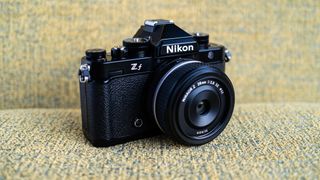
Buy it if...
You want a camera that looks as good as it performs
The Z f is a beautifully designed camera with enjoyable retro-inspired handling, plus it packs a technological punch alongside producing excellent image quality.It's a great all-rounder.
You enjoy tactile direct access controls
Modern camera design provides quick and easy access to controls, but there’s something arguably sterile to this when compared to traditional dials and switches that provide a more tactile approach to photography.
You use vintage Nikon lenses
If you own vintage Nikon F-mount lenses, once attached to the Z f via the FTZ II Mount Adaptor, the manual focus features provided by the Z f are among the best we’ve seen in a digital camera.
Don't buy it if...
You need a small and lightweight camera
The overall shape of the Z f, with the tiny grip on the front of the camera, make its footprint smaller than many other full-frame cameras. But it’s certainly not small and weighs in at 1 lb. 9.1 oz / 710g.
You mostly use long telephoto lenses
With little in the way of a grip and no thumb grip on the back of the body, there are better balanced Z-series cameras for use with larger lenses.
You need to capture 8K video
8K video is much more than the vast majority of enthusiasts and even professional photographers currently need, but if this is a resolution you require to future-proof video work, consider the Nikon Z 8 instead.
Nikon Z f: Also consider
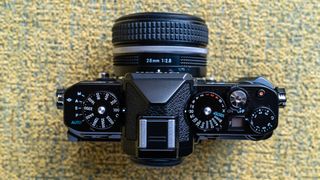
If our Fujifilm Nikon Z f review has inspired you to think about other options, here are two more retro cameras to consider…
Fujifilm X-T5
Another modern mirrorless alternative for old-school photographers, the X-T5 packs a smaller APS-C sensor with higher resolution 40MP images. Like the Zf, it has the manual exposure dials, but the X-T5 is also blessed with a wide range of retro lenses with aperture dial, and it costs a little less.
Read our full Fujifilm X-T5 review
Nikon Z6 II
The Z f takes much of its core spec from the Z6 II, including the full-frame 24.5MP sensor and 3.69m-dot EVF. With DSLR-style handling, the Z6 II handles better with long lenses, and is a better performer for action and events photography because it utilizes faster CFExpress memory. However, the similarly priced Z f packs the retro charm and, coming three years later, boasts some of its own technological prowess, including the latest processor and autofocus system.
Read our full Nikon Z6 II review
How I tested the Nikon Z f
The Nikon Z f was tested over several shoots covering a range of different subjects to test features, handling, image quality and overall performance using two different lenses. Most images were shot simply to see how the camera performed in different situations, while others were shot specifically for being able to compare the results of specific settings.
This approach provides the ability to test all aspects of the camera in a real-world environment that’s closer to how photographers will use the camera themselves, rather than relying on statistics and lens charts that do provide incredibly useful information, but do so in a way that removes interpretation of what you can and can’t see.
With nearly 30 years of photographic experience and 15 years working as a photography journalist, I’ve covered almost every conceivable subject and used many of the cameras and lenses that have been released in that time. As a working photographer, I’m also aware of the factors that are most important to photographers and aim to test cameras and lenses in a way that reflects this.
- These are the world's best mirrorless cameras
- Or check out our guide to the best cameras for photography
First tested October 2023.
James Abbott is a professional photographer and freelance photography journalist. He contributes articles about photography, cameras and drones to a wide range of magazines and websites where he applies a wealth of experience to testing the latest photographic tech. James is also the author of ‘The Digital Darkroom: The Definitive Guide to Photo Editing’.
- Timothy ColemanCameras editor
Most Popular


